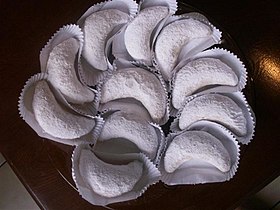The tcharek msaker (from the Arabic qarn eghzel), or tcharek or tcharak[1] (which means "croissant"), are Algerian pastries in the shape of croissants[2],[3] almond-based.
| Tcharek Msaker | |
 Tcharak msaker. | |
| Other name(s) | Tcharek |
|---|---|
| Place of origin | Algiers (Algeria) |
Origin and etymology edit
This pastry finds its origin in the ramparts of the city of Algiers.
Varieties edit
Algeria has several varieties of gazelle horns, including the most famous:
- tcharak msaker[4] (meaning in Algerian Arabic "tcharak sprinkled with sugar"), a specialty that is made mainly with almond paste, flavored with orange blossom water and, as its name suggests, sprinkled with powdered sugar;
- tcharak el ariane[5] (meaning in Algerian Arabic "bare tcharak"), a shortbread specialty that is not decorated like other tcharak and has a particular crescent shape of pastry. However, this variety is often decorated with crushed or flaked almonds, pistachios and rarely with coconut;
- glazed tcharek, a speciality that remains close to the other tcharak, but the decoration is more aesthetic. After cooking, this gazelle horn immediately receives a colored and fruity glaze. We sometimes discover very original decorations and glazes of all colors, shapes or patterns (flowers, sequins, ribbons ...);
- tcharek maasel (means in Algerian Arabic "tcharak of honey"), as its name indicates it, this variety is plunged at the end of cooking in a syrup of honey scented with water of orange blossom and citrus fruits. It is distinguished by its twisted shape;
- tcharek nakache (means in Algerian Arabic "pinched tcharak"), speciality which is very often prepared on the basis of date paste as stuffing, then decorated with a dough clip giving it a decorative aspect "pinched".
Consommation edit
The tcharak is very much consumed during the religious festival of Eid el-Fitr, but also in festivals such as circumcisions, weddings, the birth of a child[6].
Notes et références edit
- ^ PERRIER-ROBERT, Annie (2012-10-18). Dictionnaire de la gourmandise (in French). Groupe Robert Laffont. ISBN 978-2-221-13403-0. Retrieved 2021-05-13.
- ^ Malek Chebel (2012). Dictionnaire amoureux de l'Algérie (in French). Paris: edi8. p. 501. ISBN 978-2-259-21779-8..
- ^ Dominique Auzias; Jean-Paul Labourdette (12 juil. 2012). Alger 2012-2013 (avec cartes, photos + avis des lecteurs) (in French). Paris: Petit Futé. ISBN 978-2-7469-6377-1.
{{cite book}}: Check date values in:|date=(help). - ^ [dead link].
- ^ "Tcharek el ariane gateaux algerien". lesfoodies.com (in français). Retrieved 4 mai 2021.
{{cite web}}: Check date values in:|access-date=(help)CS1 maint: unrecognized language (link). - ^ Éric Michel (2007). Algérie ! Algérie ! (in French). Paris: Presses de la Renaissance. p. 489. ISBN 978-2-7509-0319-0..